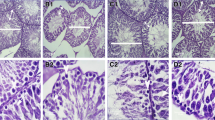Abstract
In this study the effect of thiazide diuretic compound on the protein and cholesterol contents in the testes of albino rats as the experimental model. The drug thiazide was administered orally daily for 10,20 and 30 days at the dose of 100mg/kg body weight. Total protein decrease in the testes of rats were evidenced may be due to the side effects of thiazide drug compound which is linked with the hyponatremia and protein metabolism. An elevated level of cholesterol contents observed in thiazide treated rats also revealed that the side effect of drug compound thiazide and also may be due to the stimulation of catecholamine which is stimulated therefore, the biochemical estimation such as protein and cholesterol in the testes after the thiazide treatment determined the effectiveness of diuretic drug compound would provide clinical evidences of their side effects.
Similar content being viewed by others
References
Arthur, M. J. (2000) Diuretic complications. Am. J. Med. Sci. 319, 10–24.
Brater, C. D. (2000) Pharmacology of diuretics. Am. J. Med. Sci. 319, 38–58.
Costanzo, L. S. (1985) Localization of diuretic action in microperfused rat distal tubles; Ca and Na transport. Am. J. Physiol. 247, F527-F535.
Ames, R. P. (1984) Coronary heart disease and the treatment of hypertension. Impact of diuretics on serum lipids and glucose. J. Cardiovasc. Pharmacol. 10, 9466-S473
Carlsen, J. E., Kober, L. and Torp-Penderson (1990) Relation between dose of bendrofluathiazide antihypertensive effect and adverse biochemical effects. Br. Med. J. 300, 975–998.
Morgon, T.O. (1990) Metabolic effects of various antihypertensive agents. J. Cardiovasc. Pharmacol. 151, 538–545.
Friedman, E. Shadel, M. and Halkin, H. (1989) Thiazide induces hypernatremia. Reproducibility by single dose reached. Large and on analysis of pathogenesis. Ann. Intern. Med. 110, 24–30.
Lowry, O. H. Rosenberg, A. L. F. and Randall, R. J. (1951) Protein measurement with folin phenol reagent. J. Biol. Chem. 193, 265–275.
Zlatkis, A., Zak, B. B. and Boyle, G. J. B. (1953) A colorimetrical method for determination of cholesterol. J. Lab. Clin. Med. 41, 486–496.
Menard, R. H., Stripp, B. and Gilette, J. R. (1974) Spironolactone and testicular cytochrome p-450 decreases formation in several species and changes in hepatic drug metabolism. Endocrinology 94, 1628–1636.
Fanestil, D. D., Vaughen, D. A. Ma, Lotiyde, R. H. and Printz, M. P. (1997) Thiazide diuratics normalize urinary calcium spontaneously hypertensive male rats. Kidney Intern. 51, 1018–1021.
Nishino, Y. Schroder, H. and Eiteby, M. F. (1983) Experimental studies on the endocrine side effects of new aldosterone antagones. Azenmiten Foshung. 38, 1800–1805.
Yashida, A., Yamad, T. and Koshikawa, S. (1971) Effect of diuretics on energy metabolism. Biochem. Pharmacol. 20(8), 1933–1942.
Ames, R. P. (1986) The effects of antihypertensive drugs on serum lipids and lipoproteins. Drug 32, 260–278.
Yadav, Hemlata and Singh, P. K. (2002) Alteration in body weight and testes weight in the albino rats after thiazide treatment. Bionotes 4, 96.
Grimm, R. H. J., Flack, J. M. and Grandits, G. A. (1996) Long-term effects on plasma lipids of diet and drugs to treat hypertension. Treatment of mild hypertension study (TOMHS) Research group. 290, 302–309.
Lithell, H. L. (1991) Effect of antihypertensive drugs on insulin, glucose and lipid metabolism. Diabetes Care 14, 203–209.
Weidman, P. and Gerber, A. (1985) Antihypertensive treatment and serum lipoprotein. J. Hypertens. 3, 297–306.
Prichard, B.N.C., Owens, C.W.I. and Wolf, A.S. (1992) Adverse reactions of diuretics. Eur. Heart J. 13, 96–103.
Fries, E. D. (1989) Critique of the clinical importance of diuretic induced hypokalemia and elevated cholesterol levels. Arch. Intern. Med. 149, 2640–2657.
Author information
Authors and Affiliations
Rights and permissions
About this article
Cite this article
Yadav, H., Singh, P.K. Effect of thiazide drug compound on the testicular protein and cholesterol contents of albino rat. Indian J Clin Biochem 18, 206–208 (2003). https://doi.org/10.1007/BF02867388
Issue Date:
DOI: https://doi.org/10.1007/BF02867388




